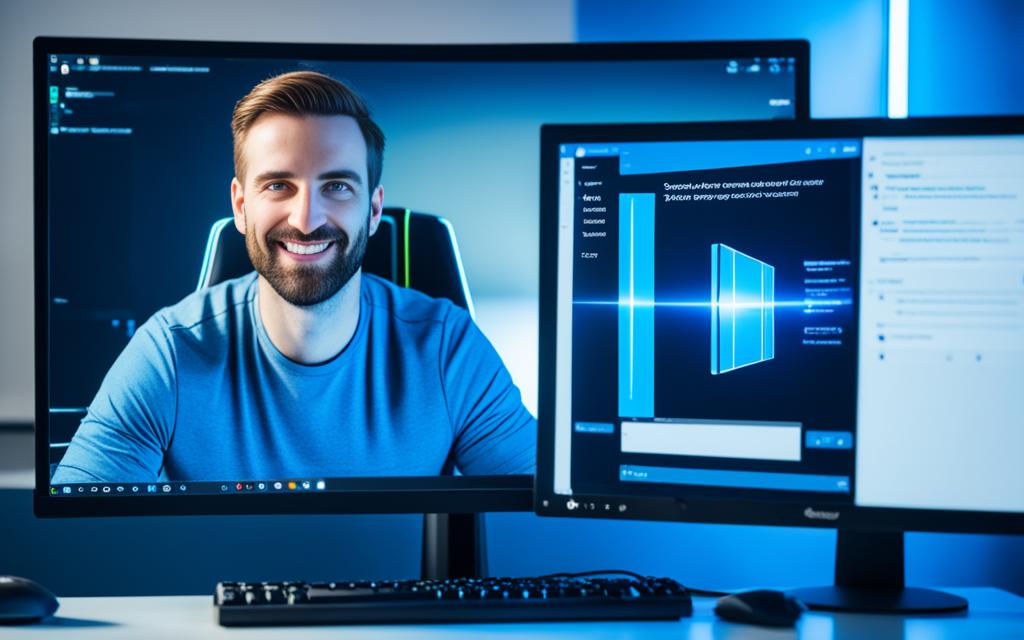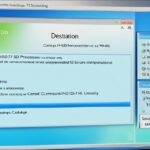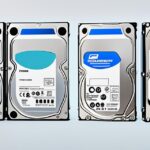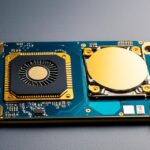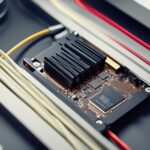Table of Contents
Switching to a new SSD is beneficial. Many people wonder if it’s necessary to reinstall Windows during this change. Luckily, with the help of OEM and Retail licenses saved on the motherboard since Windows 8, there’s often no need to buy a new license. This means you can move to your new SSD smoothly, keeping your old settings and files.
Disk cloning software makes this system upgrade easy. It helps you keep everything just the way it was.
Using reliable tools is key for a smooth SSD upgrade. This keeps your work going without interruptions. For those looking to learn more about a hassle-free switch, check out this detailed guide. It shows how to boost your system without the need for a clean install, making the upgrade process enjoyable.
Key Takeaways
- SSD upgrades significantly boost your computer’s performance.
- Reinstalling Windows is usually not needed for SSD migration.
- Disk cloning software is crucial for easy system shifts.
- New Windows licenses are not needed for hardware upgrades.
- Switching from HDD to SSD greatly improves boot times.
The Advantages of Upgrading to an SSD
Moving to an SSD can make your computer work much faster. The SSD advantages stand out in performance, boot times, and reliability. Knowing these benefits will change how you use your computer.
Improved Performance
Switching to an SSD greatly improves how fast your computer works. SSDs are up to a hundred times faster than HDDs. This speed boost makes opening files and running programs much quicker2. It’s great for using many apps at the same time or for heavy-duty tasks.
Faster Boot Times
SSDs also make your computer start up really quickly. What used to take minutes now takes just seconds3. Fast startup changes how you use your computer, making everything more smooth and efficient.
Enhanced Reliability
Choosing a reliable storage is important. SSDs don’t have moving parts, so they’re less likely to break from bumps or drops3. They last longer, which is good for keeping your data safe. Plus, SSDs are quiet, making them ideal for both home and office2.
In conclusion, getting an SSD offers big benefits for all kinds of users. If you want faster performance, quick startup, or a dependable storage, upgrading to an SSD is a smart choice3.
Understanding Different Types of SSDs
When you’re looking to boost your gaming PC, it’s key to know about types of SSDs. Understanding the differences between SATA, M.2, and NVMe SSDs helps you make a smart SSD selection.
SATA SSDs vs. M.2 SSDs
SATA SSDs offer a big speed increase compared to old HDDs. They can be up to 10 times faster for certain tasks4. M.2 SSDs, on the other hand, connect straight to the motherboard. This means quicker data transfers and less waiting around. If speed is what you’re after, M.2 drives are often the best. But, SATA drives are still a good, cheaper choice for many users.
NVMe SSDs Explained
NVMe SSDs really step up the game with the PCIe interface. This setup allows for higher speed than SATA connections. For those who want the fastest speeds, NVMe drives are key. They perform better than both SATA and M.2 drives in tough situations.
Choosing the Right SSD for Your Needs
It’s critical to think about speed, capacity, and compatibility when picking an SSD selection. For example, a 1TB SSD might cost between $30 to $50, usually a bit more than HDDs4. Knowing what you need matters, especially for serious gamers who need quick responses. Also, 75% of people don’t have to reinstall Windows with a new SSD, making compatibility a big plus5. Do use detailed resources to help make your choice when upgrading your system.
Do I Have to Reinstall Windows with a New SSD?
Are you wondering if you need to reinstall Windows when you get a new SSD? It’s crucial to know the difference between reinstalling Windows and cloning your current system. This knowledge can make the SSD installation process smoother.
Reinstalling Windows vs Cloning
Reinstalling Windows gives your system a fresh start. It gets rid of old files and settings that might slow your computer down. However, it means you’ll have to set up your system from scratch. On the other hand, disk cloning software such as EaseUS Disk Copy allows a smooth transfer of everything to the new SSD. It moves all your data, installed applications, and settings6.
This method is quick and hassle-free. For a 256 GB SSD, cloning takes about 12-15 minutes. It can transfer data at speeds up to 400MB/s. So, it’s a fast way to upgrade your system without losing anything6.
The Process of Cloning Windows to Your New SSD
Cloning your system to a new SSD is easy, even for tech novices. First, connect the new SSD with the right cables. EaseUS Disk Copy offers simple tools for cloning Windows 10 to your new drive. It helps in various situations, such as moving from a smaller to a larger SSD or from an HDD6.
The software provides step-by-step guidance, including how to adjust partitions automatically. It makes the cloning approach user-friendly for many people.
By choosing disk cloning, you can skip the long process of reinstalling Windows. This way, you get to keep your familiar system but on a faster and more reliable SSD. It makes the entire SSD installation process easier and more efficient.
Preparing for Your SSD Installation
Before you start putting in a new SSD, getting ready is key to a hassle-free change. Good preparation helps your SSD work better and keeps your data safe while moving it. First, you need to gather some things. This includes a USB-to-SATA adapter or SSD enclosure, and disk cloning software like EaseUS Partition Master. These tools let you move your Windows OS without a fresh install.
Tools and Software You’ll Need
Having the right tools makes the SSD setup easier. You’ll need a USB flash drive with the Windows install media, and screwdrivers to fit the SSD in place. Also, software like AOMEI Backupper can help. It gives you options to clone your disk and align your SSD. This improves your SSD’s performance after you’ve installed it78.
Checking Your System Compatibility
It’s crucial to check if your system accepts the new SSD. Make sure to look up the needed interfaces, like SATA or NVMe. It depends on your SSD type. Also, see if your motherboard will work well with it. By doing this, you dodge possible problems. It paves the way for a smooth SSD setup, making your computer faster and more efficient78.
FAQ
Do I need to reinstall Windows when upgrading to a new SSD?
No, reinstalling Windows isn’t needed when you switch to a new SSD. Disk cloning software makes it easy to move your current system over.
What are the benefits of upgrading to an SSD?
Switching to an SSD brings many advantages. You’ll see faster performance and shorter boot times. It’s more reliable than traditional HDDs, benefiting everyone from everyday users to serious gamers.
What types of SSDs are available in the market?
You’ll find SATA SSDs and M.2 SSDs on the market. M.2 drives plug right into the motherboard, offering quick speeds. NVMe SSDs use even faster technology for rapid data transfer.
How does cloning work when upgrading to a new SSD?
Cloning lets you move your current Windows setup and all data to a new SSD. This is done using disk cloning software, so you don’t need to start from scratch.
What tools do I need to prepare for my SSD installation?
You’ll need a USB-to-SATA cable or an SSD enclosure to connect your SSD to the computer. Reliable disk cloning software like EaseUS Disk Copy is also essential.
How can I check my system compatibility with a new SSD?
Check your motherboard’s specs to see if it supports the SSD you want. This ensures everything will work smoothly after the upgrade.
What should I do before initializing my new SSD?
Before you start, make sure the SSD is correctly connected. You should also check system compatibility and install any necessary software or drivers.
Source Links
- https://www.wps.com/blog/how-to-install-windows-1011-on-new-solid-state-drive-ssd-in-easy-steps/ – How to Install Windows 10/11 on New Solid State Drive(SSD)? (In Easy Steps) | WPS Office Blog
- https://www.kingston.com/en/blog/pc-performance/benefits-of-ssd – The 5 Benefits of SSDs over Hard Drives- Kingston Technology
- https://www.diskpart.com/windows-10/install-windows-10-on-ssd-4348.html – How to Install Windows 10 on SSD Easily and Successfully
- https://www.backblaze.com/blog/ssd-upgrade-guide/ – How to Upgrade Your Computer: Migrating from HDD to SDD
- https://rog-forum.asus.com/t5/tuf-asus-gaming-notebooks/fresh-windows-install-on-new-ssd/td-p/961492 – Fresh Windows install on new SSD
- https://www.pcworld.com/article/1995663/clone-windows-10-to-ssd-without-reinstalling-everything-2.html – Clone Windows 10 to SSD Without Reinstalling Everything
- https://www.easeus.com/partition-master/install-windows-10-on-ssd.html – How to Install Windows on SSD via 2 Easy Ways 🏆
- https://www.ubackup.com/windows-10/install-windows-10-to-ssd.html – Directly Install Windows 10 on New SSD with/without CD | 2 Ways

